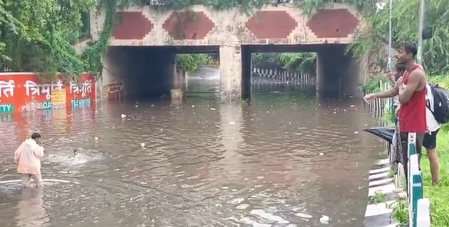
New Delhi, July 29 (IANS) Heavy rainfall battered parts of Delhi and the National Capital Region (NCR) on Tuesday, bringing with it widespread waterlogging, traffic chaos, and yet another reminder of the city’s persistent drainage woes.
While the showers offered a much-needed break from the sultry heat, they also exposed glaring inefficiencies in civic preparedness by the Delhi government, leaving roads submerged and daily life disrupted.
One of the worst-hit areas was North Delhi’s Zakhira underpass, where nearly six feet of water collected, completely halting vehicular movement between Zakhira and Moti Nagar.
The underpass was shut to traffic as visuals from the site showed two-wheelers daring the waterlogged stretch while pedestrians and children waded through waist-deep water— some cautiously, others gleefully.
Despite repeated promises by civic authorities that the city’s drainage systems were monsoon-ready, just a few hours of rain laid bare the ground reality. With streets turned into streams and vehicles stranded, the chaos mirrored the national Capital’s recurring monsoon mismanagement.
Residents questioned the effectiveness of the Delhi government’s pre-monsoon clean-up claims, which now appear hollow in the face of flooded roads and crippled traffic.
At the Zakhira underpass, three pumps were deployed by the Public Works Department (PWD) to drain out the accumulated water. However, only two were operational, with workers scrambling to repair the third, further slowing the dewatering process.
The situation was not limited to Zakhira. Across New Delhi, waterlogged streets turned commuting into a nightmare. At Windsor Road, large stretches of the road were submerged, causing major traffic disruptions.
In Kirari Assembly constituency, poor drainage led to extensive water accumulation, forcing vehicles to crawl and drivers to navigate carefully through flooded roads.
Akshardham, another key location, was also hit hard by waterlogging, with visuals showing vehicles stranded and long queues forming on the roads. Frustrated commuters battled traffic snarls for hours as stormwater refused to drain away.
According to the India Meteorological Department (IMD), Delhi recorded 8 mm of rainfall during the 24-hour period ending at 8:30 A.M. on Tuesday. The minimum temperature dipped slightly to 26.8 degrees Celsius — 0.5 degrees below the seasonal average —offering some relief from the previous days’ heat and humidity. Relative humidity was recorded at 70 per cent in the morning.
The IMD has issued a Red Alert for southeast and northeast NCR and a Yellow Alert for southwestern and southeastern parts, warning of continued heavy rainfall and thunderstorms in the coming days.
While the downpour wreaked havoc on roads, it also had its silver linings. The monsoon showers brought down the temperature, cleansed the air, and improved the Air Quality Index (AQI) in several parts of Delhi-NCR. With dust and pollutants washed away, residents enjoyed a rare chance to breathe cleaner air.
In areas like Noida, Greater Noida, and Ghaziabad, AQI levels fell into the ‘satisfactory’ range — a welcome change for a region often ranked among the most polluted in the world.
Health experts noted that the improved air quality, coupled with cooler temperatures, would provide relief to vulnerable populations, especially the elderly, children, and those with respiratory issues.
Looking ahead, the IMD has forecast cloudy skies and moderate rainfall for the rest of the week, with temperatures expected to hover around 30 degrees Celsius. Thunderstorms and localised downpours may continue to affect parts of Delhi-NCR until August 3.
The IMD has also predicted heavy to extremely heavy rainfall across various parts of the country until August 4.
Northwest India — including East Rajasthan and Himachal Pradesh — is expected to witness intense rainfall on July 29, while regions like Uttarakhand, Punjab, and Haryana may also see heavy showers.
Western India, including Konkan and Gujarat, is likely to experience isolated heavy rainfall, with moderate showers continuing over the next several days.
–IANS
jk/rad



